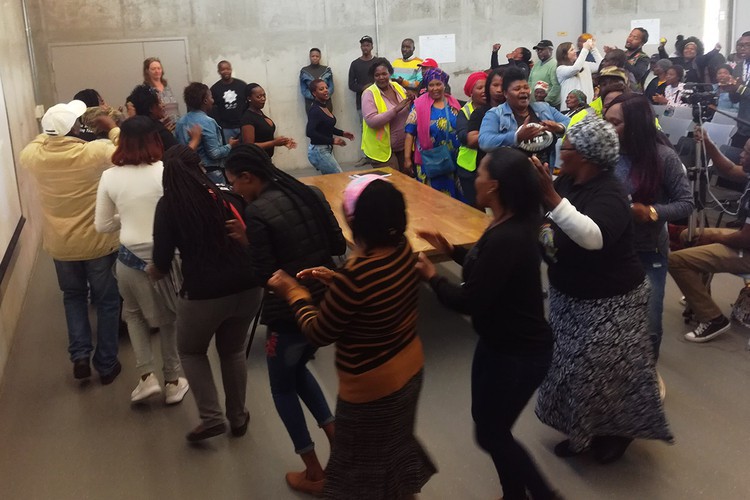
Residents, mostly from Khayelitsha, attended the third annual Policing and Social Justice Dialogue at the Isivivana Centre in Khayelitsha on Thursday. Photo: Barbara Maregele
29 September 2017
The lack of resources for young people in poor communities often leads to them to joining gangs and doing drugs. This was the view of several people who spoke out at the third annual Policing and Social Justice Dialogue on Thursday.
“I grew up in Site B and most of my friends are and were gangsters there. Now they are all messed up. We need more programmes for kids who aren’t at school anymore because those are the ones causing the trouble,” said local artist Sizwe Ngune.
Nearly 120 people attended the event, hosted by the Social Justice Coalition at the Isivivana Centre in Khayelitsha. During the two-day event, which started on Thursday, residents from different communities are discussing a range of topics such as youth gangs, police brutality and sexual violence.
“We should be working with those who were gangsters to help the children today … We also want to know how ward councillors allocate funds to projects focused on the youth,” Ngune said.
He was responding to a presentation by Amanda Dissel from the Western Cape Department of Community Safety. During her presentation, Dissel said that 13.4% of the murders for the 2015/16 period in the Western Cape were gang-related. She said that according to South African Police Service (SAPS) statistics released in May 2017, 76% of the attempted murder cases in Bishop Lavis were gang-related.
Dissel said Khayelitsha was not prioritised as a gang station because gangs in the area did not operate like those in Mitchells Plain and other areas on the Cape Flats. “Many gangs in Khayelitsha were groupings of girls and boys who are generally violent towards each other … There are many reasons why people join gangs such as poverty, broken families, imprisonment, absent fathers and not having any meaningful activity in their lives,” she said.
Dissel said one of the 20 recommendations of the commission of inquiry into policing, released in August 2014, was for a multi-sectoral task team to be established to deal with youth gangs in the area.
The commission also found that there were fewer police resources allocated to poor areas where crime levels are higher compared to wealthier areas.
Dissel said that since then, a national anti-gangsterism strategy was adopted by the provincial government in January 2017. “It recognises that gangsterism is not only a law enforcement responsibility, but requires a number of role players to deal with the root causes of the problem,” she said. To date, ten schools have been identified to pilot new safety hubs. One of these is Bulumko Secondary School in Khayelitsha where safety officials and neighbourhood watch members will be stationed, Dissel said.
She also spoke about a number of school and community safety initiatives run by the Department. Dissel said that according to a survey conducted on 1,400 young people in Khayelitsha between 2013 and 2015, there was a close association between alcohol and violence. “More than 50% of the people attending the Khayelitsha health facilities were under the influence of alcohol,” she said.
In response, resident Patricia Bosman asked, “Why don’t we have more rehabilitation centre in our communities for the young people?”
Another resident, who asked not to be named, said, “There will be less violence and gangsterism if our children had something to do after the school day ends at 2pm. There are no pools here, no nice fields, nothing. We need our government to be innovative to create more opportunities and things to keep the children occupied.”
Vuyani Mngqete questioned Dissel on the lack of safety attire given to neighbourhood watch groups, while those in wealthier areas had more resources. “We are also glad that there are cameras in the community, but who are the people monitoring those cameras?”
Dissel acknowledged that some of the 16 CCTV cameras in Khayelitsha were often not working and the response by the police to crime scenes was “not good enough”. Dissel challenged residents to also take responsibility and encourage young people to use the facilities in the area. “How many of you see children in the streets and tell them to go to the various programmes,” she said.
“Is all of this enough? No. But there are so many initiatives underway already which need the help of the community to make them better,” she said.